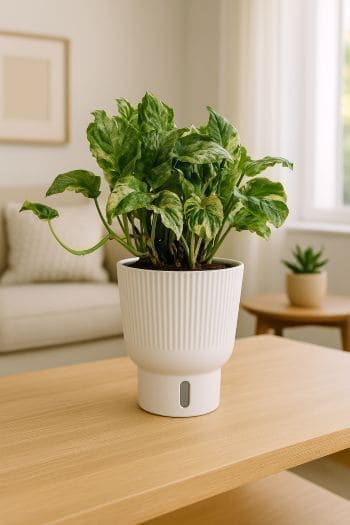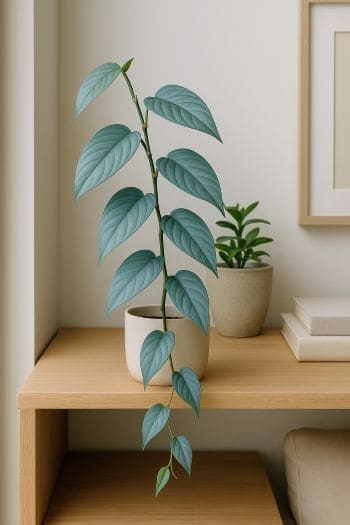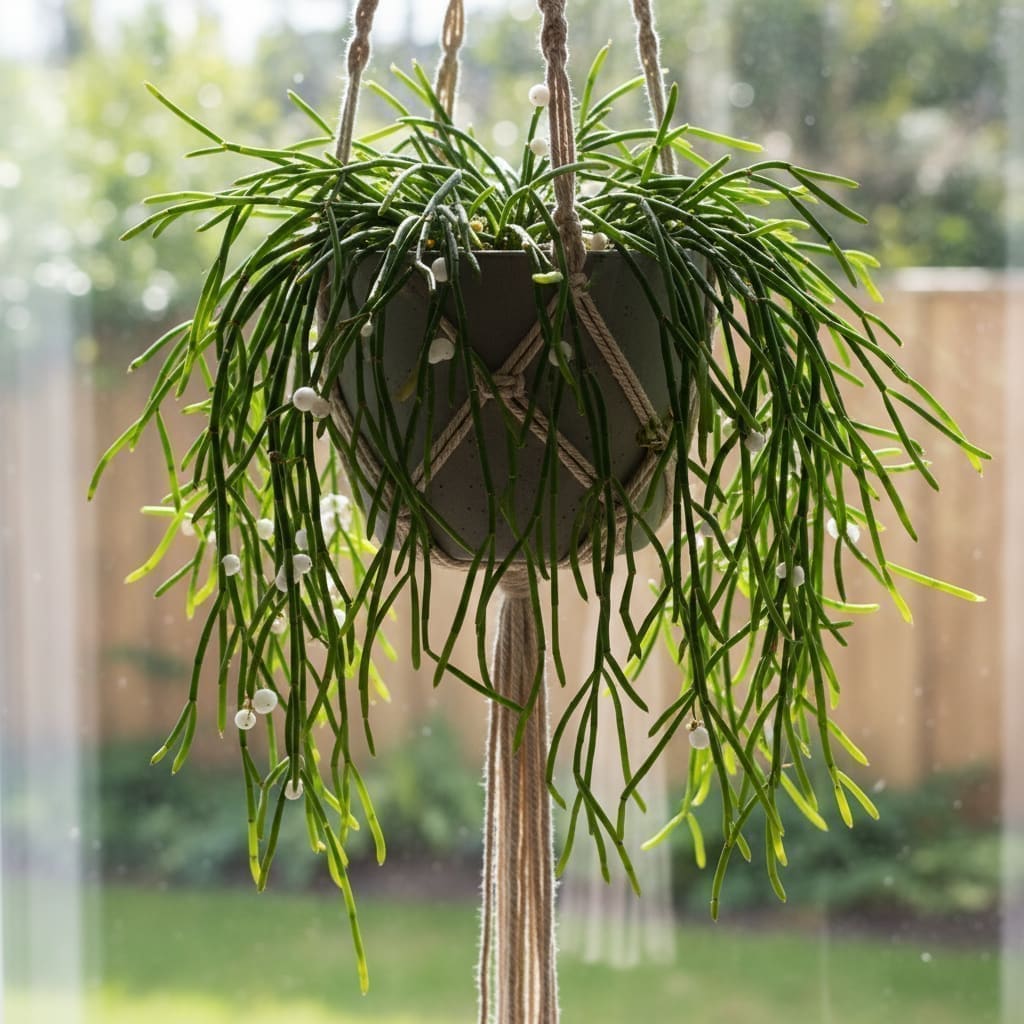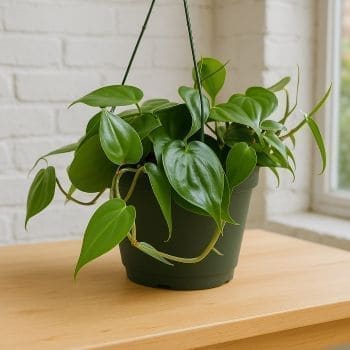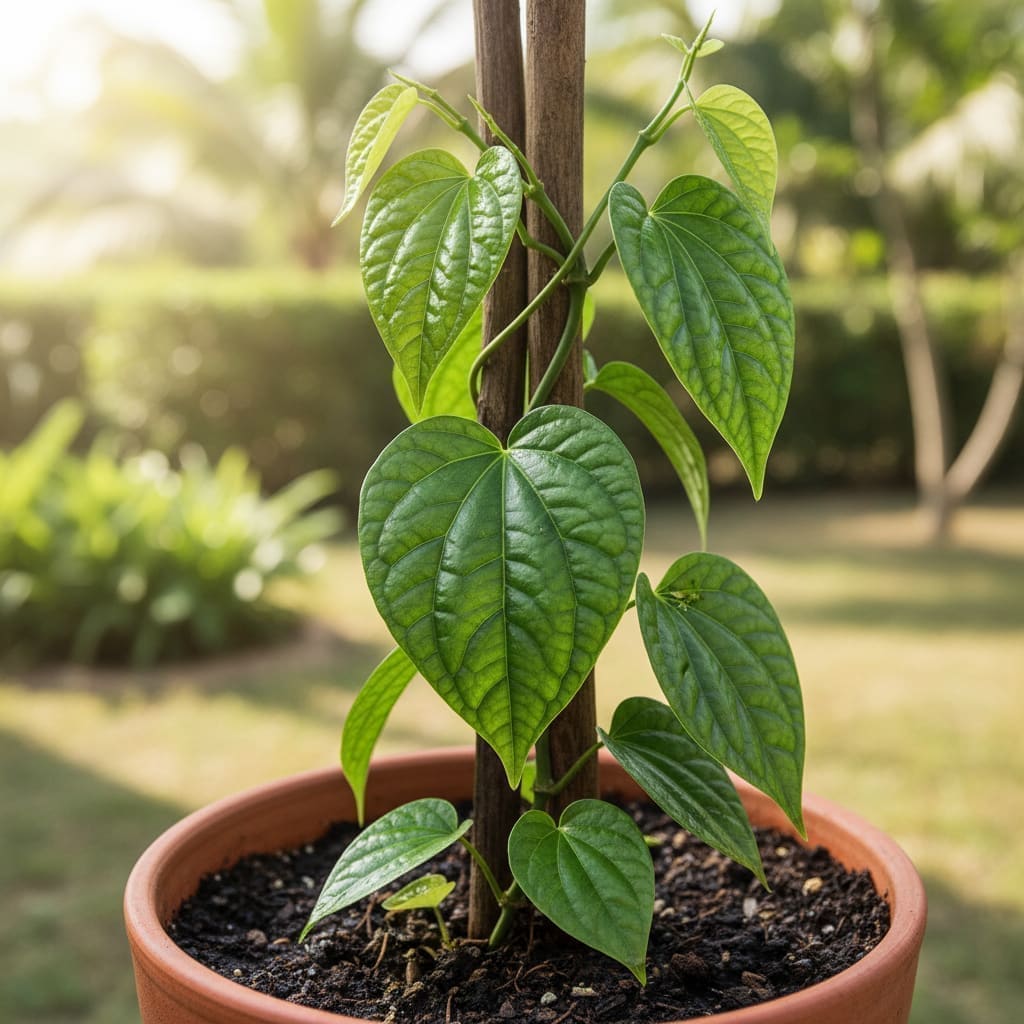Epipremnum aureum ‘Shangri-La’ Care & Growing Guide
Overview
Epipremnum aureum ‘Shangri-La’, commonly known as the Shangri-La Pothos or “curly pothos,” is a striking tropical houseplant native to Southeast Asia. This cultivar is prized for its unusually twisted, scroll-like leaves that set it apart from other pothos varieties. Adaptable and relatively low-maintenance, it thrives in a range of indoor environments, making it a favorite among both novice and experienced plant keepers.
In its natural habitat, this plant grows as a trailing or climbing vine, using aerial roots to cling to trees and other structures. Indoors, it can be trained to climb a moss pole or allowed to cascade from a hanging basket for a lush, decorative effect.
Identification & Growth Habit
The Shangri-La Pothos is easily identified by its deep green, heavily textured leaves that curl and twist inwards. Mature leaves can reach 4–6 inches in length, though size varies depending on growing conditions. The plant’s vining stems can extend several feet over time, making it suitable for both trailing and climbing displays.
- Leaf shape: Rolled, twisted, and sometimes slightly puckered.
- Growth form: Trailing or climbing vine with aerial roots.
- Mature size indoors: 3–6 feet of vine length with proper care.
Light & Placement
Place your Shangri-La Pothos in medium to bright, indirect light for optimal growth. It will tolerate lower light levels, but growth will slow and leaf color may become less vibrant. Avoid direct sun exposure, which can scorch the foliage.
- Ideal spot: Near an east- or north-facing window, or a few feet back from a bright south/west window with sheer curtains.
- Low light tolerance: Yes, but with reduced vigor.
Watering & Humidity
Water when the top 2–3 inches of soil are dry to the touch. Use room-temperature water and allow excess to drain completely to prevent root rot. Overwatering is the most common cause of decline in pothos plants.
This plant appreciates moderate to high humidity. In drier climates or during winter heating, increase humidity by:
- Misting the foliage lightly (avoid over-wetting).
- Using a pebble tray with water beneath the pot.
- Placing near a humidifier.
Soil & Repotting
Use a well-draining potting mix rich in organic matter. A blend of peat moss, perlite, and standard potting soil offers a good balance of moisture retention and aeration.
- Repotting frequency: Every 1–2 years, or when roots become crowded and growth slows.
- Choose a pot with drainage holes to prevent waterlogging.
Fertilizing
Feed monthly during the active growing season (spring and summer) with a balanced liquid houseplant fertilizer diluted to half strength. Reduce feeding in autumn and stop entirely in winter, when growth naturally slows.
Pruning & Training
Regular pruning helps maintain a compact shape and encourages bushier growth. Use clean, sharp scissors or pruners to trim stems just above a node.
For climbing displays, provide a moss pole, trellis, or other support. Secure vines gently with soft ties, encouraging aerial roots to attach to the support for stronger vertical growth.
Propagation
Shangri-La Pothos propagates easily from stem cuttings. Here’s a step-by-step guide:
- Select a healthy vine and cut just below a node (the point where leaves and aerial roots emerge), ensuring the cutting has at least 2 leaves.
- Remove the leaf closest to the cut end to expose the node.
- Place the cutting in a jar of clean water or directly into moist, well-draining soil.
- If rooting in water, change the water every few days to keep it fresh.
- Roots typically develop within 2–4 weeks. Once roots are 1–2 inches long, transplant water-rooted cuttings into soil.
Common Problems
Pests
- Spider mites: Look for fine webbing and stippled leaves. Treat by rinsing foliage and applying insecticidal soap.
- Mealybugs: White, cottony clusters on stems and leaf joints. Remove manually with a cotton swab dipped in alcohol, then monitor closely.
- Scale insects: Brown, shell-like bumps. Scrape off gently and treat with horticultural oil.
Diseases
- Root rot: Caused by overwatering or poorly draining soil. Remove affected roots and repot in fresh, well-draining mix.
- Leaf spot: Brown or black spots, sometimes with yellow halos. Remove affected leaves and improve air circulation.
Toxicity & Pet Safety
Like other pothos varieties, Epipremnum aureum ‘Shangri-La’ is toxic to cats, dogs, and humans if ingested, due to insoluble calcium oxalates. Keep out of reach of pets and children, and wear gloves if you have sensitive skin when pruning.
Styling & Decor Tips
- Display in a hanging basket to showcase its trailing vines.
- Train up a moss pole for a dramatic vertical accent.
- Pair with contrasting foliage plants (e.g., variegated species) for a dynamic indoor jungle look.
- Use decorative cachepots to complement the plant’s deep green leaves.
Varieties & Cultivars
The Shangri-La is a unique cultivar within the Epipremnum aureum species. While it shares care requirements with other pothos types like ‘Golden Pothos’ or ‘Marble Queen,’ its tightly curled leaves make it instantly recognizable. No widely recognized variegated form of Shangri-La is currently established in the market.
Buying Tips & Maturity
When purchasing, look for plants with firm, richly colored leaves and no signs of pests or yellowing. Younger plants may have shorter vines and less pronounced leaf curl; as the plant matures, the twisting effect becomes more dramatic. Check the root system if possible—healthy roots should be white or light tan and firm to the touch.
Seasonal Care
- Spring/Summer: Active growth period. Increase watering frequency slightly, fertilize monthly, and consider repotting if rootbound.
- Autumn: Gradually reduce feeding and watering as growth slows.
- Winter: Water sparingly, maintain stable temperatures, and keep away from cold drafts or heating vents.
FAQ
- How fast does Shangri-La Pothos grow? Growth rate is moderate; faster in bright, indirect light and warm, humid conditions.
- Can it live in low light? Yes, but growth will slow and leaves may be less vibrant.
- Why are my Shangri-La leaves unfurling flat? This can occur in lower light or if the plant is stretching; provide more light for tighter curls.
- Does it need a moss pole? Not required, but climbing support can produce larger, more mature leaves.
- How often should I repot? Typically every 1–2 years, or when roots fill the pot.
